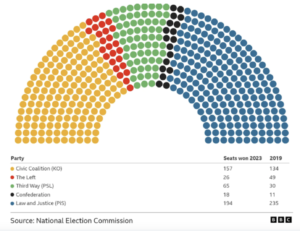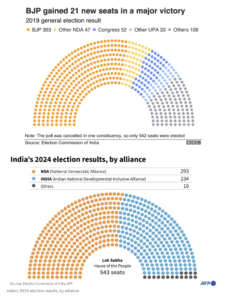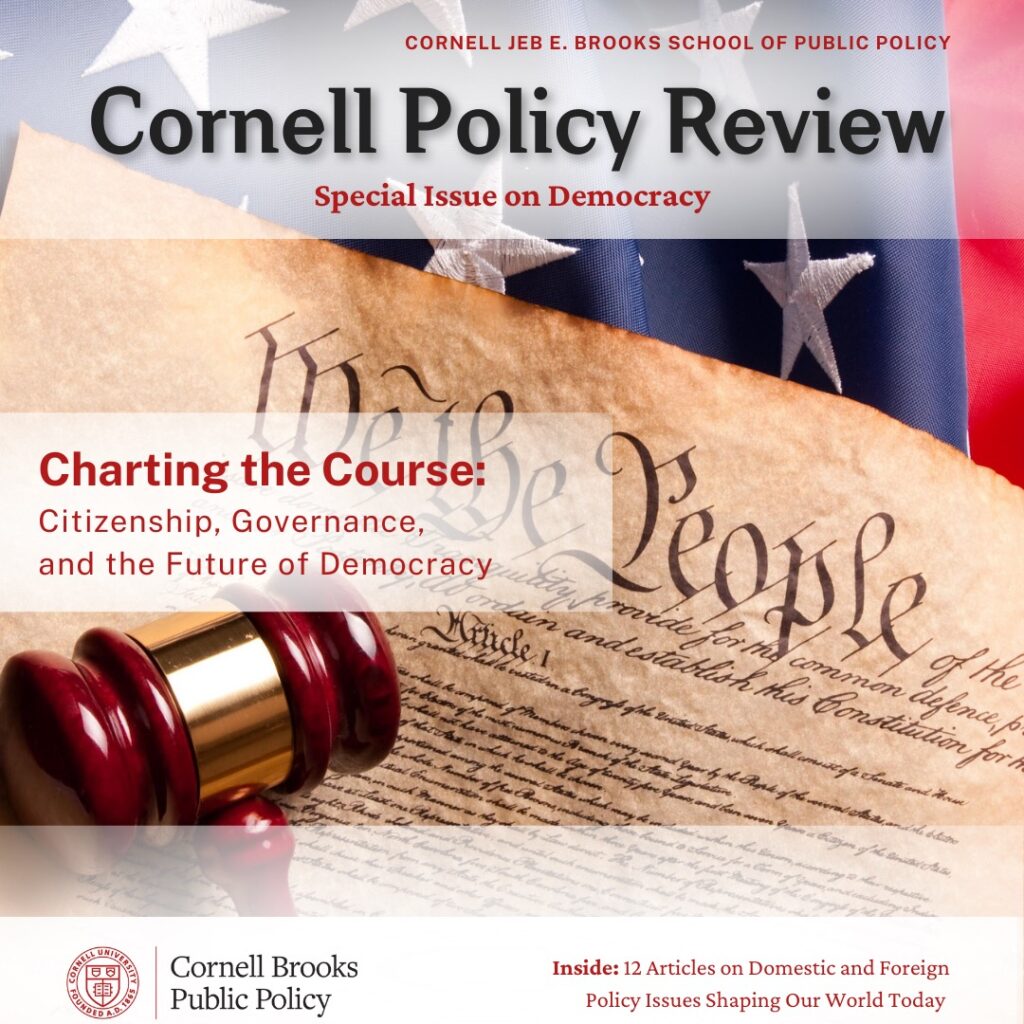By: Kaila Hall
Edited by: Andrew Bongiovanni
Graphic by: Arsh Naseer
Introduction
As the world witnesses recent far-right trends, many have sought to pinpoint the strategies that successful opposition movements have implemented to defeat autocratic rule in elections. For example, Poland is increasingly viewed as a successful model of recovery while India possesses a weak opposition coalition. Beginning in 2015, the far-right Polish Law and Justice Party (PiS) began capturing the independent judiciary by court packing after the Parliamentary Elections. These reforms ushered in a period of backsliding, or the use of institutions to restrict rights and participation.1 Subsequently, the oppositional Civic Coalition (KO) rebuilt itself in the years since and defeated PiS in the most recent elections in October 2023 by vowing to reverse its opponents’ policies and mobilizing young voters. However, in India’s case, the oppositional Indian National Developmental Inclusive Alliance (INDIA) had failed to gain significant traction in reversing democratic erosion by current Prime Minister Narendra Modi and his Bharatiya Janata Party. Leading up to the 2024 election cycle, Modi’s administration implemented the controversial Citizenship Amendment Act,2 pushed news outlets to fire journalists, and jailed critics and several key political opponents. As expected, Modi’s National Democratic Alliance (NDA) coalition defeated the INDIA coalition in the 2024 Election, although by a smaller margin than previously anticipated. Currently, Poland is on track to recover as opposed to India which remains susceptible to anti-democratic rule under Prime Minister Modi for several years to come.
Poland, A Success Story
Democratic backsliding began as the nationalist Law and Justice Party won in the 2015 Elections and began stacking the constitutional court with loyalist judges. Subsequently, they usurped the National Council of the Judiciary which protects the independent judiciary. In the following years, approximately 3,000 new judges were unconstitutionally3 packed by the Law and Justice-led government. Criticism of these reforms was highly suppressed through new procedural rules and the firing of judges. Thirty percent of Poland’s judges today were appointed by the Law and Justice Party. Consequently, this ensured the courts could block challenges to PiS reforms.
Despite the Law and Justice Party’s judicial capture, the opposition movement, known as the Civic Coalition, defeated PiS in the recent Polish Parliamentary Elections in October 2023. Poland’s National Assembly is a bicameral system4 that includes the Sejm (parliament), which contains 460 deputies, and the Senate, which contains 100 senators. Members of the Sejm are elected for four-year terms. These elections use party-list proportional representation, meaning each party must win at least five percent of the vote and coalitions must win eight percent of the vote to earn seats. To form a government, a party or coalition must reach a minimum of 231 votes in the Sejm. The Senate is elected on a first-past-the-post system.5 The Civic Platform (KO) Party is led by former European Council President and current Prime Minister Donald Tusk and comprises a few smaller liberal parties and the center-right party. The 2023 Election results constitute “a major shift from democratic backsliding to a recommitment to EU values and democratic principles, with implications for regional stability and U.S. foreign policy,”6 according to Robert Benson of the Center for American Progress.
2023 and 2019 Election Results Comparison
To produce this shift, the Civic Coalition mobilized key demographic groups. By engaging with young voters, polls show that sixty-eight-point eight percent of voters aged under twenty-nine turned out in the 2023 Election- a major surge from forty-six-point four percent at the last parliamentary election in 2019. Additionally, the KO led an online initiative to mobilize voters. Campaigns such as the #WarsawTrip urged people to move their registration out of densely populated cities like Warsaw, to give their vote more weight in the complex Polish electoral system. Another online campaign urged women to vote against PiS which implemented a near-total ban on abortion in 2020. Upon winning the election, Donald Tusk pledged to restore the independent judiciary, garner a closer relationship with the EU, and pursue his “iron broom” strategy7 to clean up Poland. Despite the Civic Coalition’s defeat in the April 2024 local government elections, PiS lost five seats in the 2024 European Union Election in June. Evidently, Poland’s opposition movement has thrived, and the country is set to reverse previous damage.
India, A Nation in Flux
Prime Minister Narendra Modi’s government has conducted raids on dissident civil society organizations through financial and investigative agencies.8 Government-run media have spewed disinformation and officials have launched attacks on media outlets in a major crackdown on the press.9,10 Modi also shut down internet access in contested and Muslim-majority areas such as Kashmir.11 Most recently, Modi’s Bharatiya Janata Party (BJP) has implemented the controversial Citizenship Amendment Act.12,13 The former president of the opposition Congress Party, Rahul Gandhi, was disqualified in March 2024 from Parliament after a political defamation scandal against Modi.
The Indian Parliamentary Elections in 2019 ended with a significant win for the BJP-led National Democratic Alliance, winning 353 of the total 543 official seats, with BJP alone winning 303 seats. The oppositional Indian National Congress Party, the main opposition party, failed to secure ten percent of seats to gain opposition leader status.14 The Parliament known as Lok Sabha is chosen by direct election. India’s Constitution allows for a maximum of 550 members in the House, with 530 members representing the States and 20 representing the Union Territories.15
As of 2024, the Indian National Developmental Inclusive Alliance (INDIA) opposition coalition comprises the Indian National Congress Party and 25 other smaller, regional parties. A loosely bound together opposition movement, the INDIA Coalition does not have any specific or unifying policy goals other than ousting Modi. In the past five months, this movement has had key leaders join the BJP and the NDA. Opinion polls leading up to the 2024 Election suggested that Modi would easily retain a majority in the Lok Sabha. However, a significant upset occurred when the BJP lost sixty-three seats and the Indian National Congress gained forty-seven seats in the June 2024 Election. As a result, the BJP lost its majority in Parliament and the NDA retained its majority, meaning Modi will now have to rely on other NDA coalition parties to pass his policies.16 Due to the recent election results, Modi is expected to rule with more caution while the INDIA opposition movement has been reinvigorated.
2019 and 2024 Election Results Comparison
Conclusion
Within the past decade, both Poland and India have experienced trends of democratic backsliding but have each adopted distinct approaches to recovery. As a result of the Civic Coalition’s win in the 2023 Election, Poland has recently undergone a turning point for its political stability and reversing democratic erosion by the Law and Justice Party. Prime Minister Donald Tusk has ensured his commitment to restoring democratic rule through his “iron broom” strategy and independent judiciary. The 2024 European Parliament Elections have discernibly reaffirmed Polish confidence in Tusk’s style of governance and reforms. While the INDIA coalition gained seats in the 2024 Election, it remains relatively weak and in the minority of the Lok Sabha nonetheless. The question now becomes how will Prime Minister Narendra Modi’s Bharatiya Janata Party rule with this momentous defeat. Regardless, both India and Poland demonstrate that there are many effective tactics and approaches towards combatting democratic backsliding, providing seeds other countries can sow to repel rising authoritarianism globally.
Works Cited
[1] Dean, James. 2024. “Democratic Decline a Global Phenomenon, Even in Wealthy Nations.” Cornell Chronicle, January 17. https://news.cornell.edu/stories/2024/01/democratic-decline-global-phenomenon-even-wealthy-nations.
[2] Saaliq, Sheikh. 2024. “India’s New Citizenship Law Excludes Muslims. Here’s What to Know.” AP News, March 12. https://apnews.com/article/india-citizenship-law-modi-muslims-caa-28909f8df0e6d5e0915e065195abef14#.
[3] Schmitz, Rob. 2024. “Poland’s Judiciary Was a Tool of Its Government. New Leaders Are Trying to Undo That.” NPR, February 26. https://www.npr.org/2024/02/26/1232834640/poland-courts-judicial-reform-donald-tusk.
[4] Sejm of the Republic of Poland. n.d. “Sejm of the Republic of Poland.” https://www.sejm.gov.pl/english/sejm/sejm.htm.
[5] Atlantic Council. 2023. “Your Primer on the Elections in Poland.” Atlantic Council, October 11. https://www.atlanticcouncil.org/content-series/eye-on-europes-elections/your-primer-on-the-elections-in-poland/.
[6] Benson, Robert. 2023. “Poland’s Democratic Resurgence: From Backsliding to Beacon.” Center for American Progress, November 14. http://www.americanprogress.org/article/polands-democratic-resurgence-from-backsliding-to-beacon/.
[7] Minder, Raphael. 2024. “Inside Donald Tusk’s Divisive Campaign to Restore Polish Democracy.” Financial Times, February 18. https://www.ft.com/content/e3b10baf-c508-4af1-ad25-8188cf60b174.
[8] Rajvanshi, Astha. “How Narendra Modi’s India Uses Raids to Silence Critics.” Time, February 16, 2023. https://time.com/6255425/india-raid-bbc-modi-documentary/.
[9] Ibid.
[10] Reporters Without Borders. “Press Freedom Index.” Reporters Without Borders: Press Freedom Index, 2024. https://rsf.org/en/index?year=2022.
[11] Goel, Vindu, Karan Deep Singh, and Sameer Yasir. “India Shut down Kashmir’s Internet Access. Now, ‘We Cannot Do Anything.’” The New York Times, August 14, 2019. https://www.nytimes.com/2019/08/14/technology/india-kashmir-internet.html.
[12] BBC. “CAA: India’s New Citizenship Law Explained.” BBC News, March 12, 2024. https://www.bbc.com/news/world-asia-india-50670393.
[13] Saaliq, Sheikh. “India’s New Citizenship Law Excludes Muslims. Here’s What to Know.” AP News, March 15, 2024. https://apnews.com/article/india-citizenship-law-modi-muslims-caa-28909f8df0e6d5e0915e065195abef14#.
[14] Express Web Desk. 2024. “Lok Sabha Elections 2024: Dates, Phases, Key Players and All You Need to Know about next General Elections.” The Indian Express, February 8. http://indianexpress.com/article/when-is/general-elections-2024-dates-phases-key-players-and-all-you-need-to-know-9150641/.
[15] “Lok Sabha | National Portal of India.” n.d. https://www.india.gov.in/my-government/indian-parliament/lok-sabha.
[16] “India Election Results: Modi Claims Victory for Alliance.” AP News, June 4, 2024. https://apnews.com/live/india-election-results-updates.




